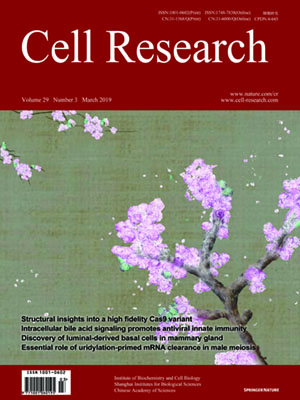
Volume 29, No 3, Mar 2019
ISSN: 1001-0602
EISSN: 1748-7838 2018
impact factor 17.848*
(Clarivate Analytics, 2019)
Volume 29 Issue 3, March 2019: 233-247
ORIGINAL ARTICLES
PARylation regulates stress granule dynamics, phase separation, and neurotoxicity of disease-related RNA-binding proteins
Yongjia Duan 1,2, Aiying Du 1, Jinge Gu 1,2, Gang Duan 1, Chen Wang 1,2, Xinrui Gui 1,2, Zhiwei Ma 1,3, Beituo Qian 1,2, Xue Deng 1,2, Kai Zhang 1,2, Le Sun 1,2, Kuili Tian 1, Yaoyang Zhang 1,2, Hong Jiang 1,2, Cong Liu 1,2 and Yanshan Fang 1,2
1 Interdisciplinary Research Center on Biology and Chemistry, Shanghai Institute of Organic Chemistry, Chinese Academy of Sciences, Shanghai 201210, China and 2University of Chinese Academy of Sciences, Beijing 100049, China 3 Present address: Shanghai Institutes for Biological Sciences, Chinese Academy of Sciences, Shanghai 200031, China
Correspondence: Cong Liu (liulab@sioc.ac.cn) or Yanshan Fang (fangys@sioc.ac.cn)These authors contributed equally: Yongjia Duan, Aiying Du, Jinge Gu.
Mutations in RNA-binding proteins (RBPs) localized in ribonucleoprotein (RNP) granules, such as hnRNP A1 and TDP-43, promote aberrant protein aggregation, which is a pathological hallmark of various neurodegenerative diseases, such as amyotrophic lateral sclerosis (ALS) and frontotemporal dementia (FTD). Protein posttranslational modifications (PTMs) are known to regulate RNP granules. In this study, we investigate the function of poly(ADP-ribosyl)ation (PARylation), an important PTM involved in DNA damage repair and cell death, in RNP granule-related neurodegeneration. We reveal that PARylation levels are a major regulator of the assembly-disassembly dynamics of RNP granules containing disease-related RBPs, hnRNP A1 and TDP-43. We find that hnRNP A1 can both be PARylated and bind to PARylated proteins or poly(ADP-ribose) (PAR). We further uncover that PARylation of hnRNP A1 at K298 controls its nucleocytoplasmic transport, whereas PAR-binding via the PAR-binding motif (PBM) of hnRNP A1 regulates its association with stress granules. Moreover, we reveal that PAR not only dramatically enhances the liquid-liquid phase separation of hnRNP A1, but also promotes the co-phase separation of hnRNP A1 and TDP-43 in vitro and their interaction in vivo. Finally, both genetic and pharmacological inhibition of PARP mitigates hnRNP A1- and TDP-43-mediated neurotoxicity in cell and Drosophila models of ALS. Together, our findings suggest a novel and crucial role for PARylation in regulating the dynamics of RNP granules, and that dysregulation in PARylation and PAR levels may contribute to ALS disease pathogenesis by promoting protein aggregation.
https://doi.org/10.1038/s41422-019-0141-z
FULL TEXT | PDF
Browse 1350


